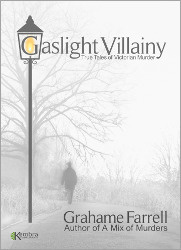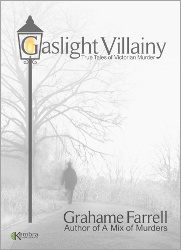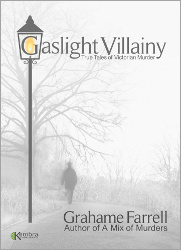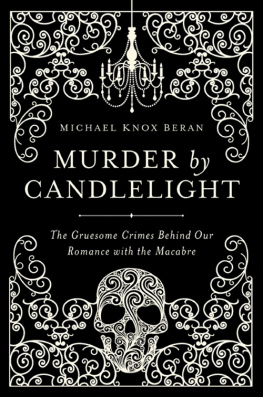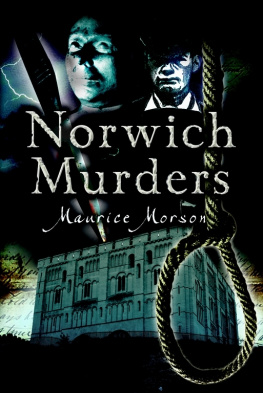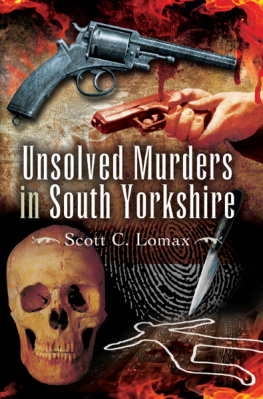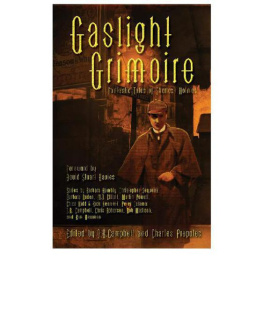Introduction

nyone who leafs through a copy of the Newgate Calendar (the compendium of summaries of convicted felons held in that prison to await their execution) will see at a glance that the majority of its early, Eighteenth-Century, cases are relatively simple affairs involving hungry people who stole or murdered in order to avoid starvation.
Although this continued to be the case in the early decades of the Nineteenth Century, it soon becomes apparent that the Victorian era represents some kind of a change. To begin with, there is something new for the murderer to confront, namely a police force organised on professional lines; and perhaps in response to this, there is, secondly, a far greater degree of subtlety in the planning and execution of Victorian murders; witness for instance the convoluted scheming of Andrew McRae in 1892, the simple efficiency, almost as in a production line of murder victims in a case I call Insured for Murder from the early 1880s, or the devious machinations of a not-so-gentlemanly aristocrat in Incident at Ardlamont in 1893.
Thirdly, we can begin to see the fruits of breakthroughs and advances in forensic science on the part of the great Spanish chemist Orfila and others, particularly in the toxicological analysis of poisons, and the means of detecting them. Examples are the cases of Catherine Wilson, Dr. William Pritchard, and the afore-mentioned life-insurance murders (all found in this book), and Dr. George Henry Lamson in 1872.
But to return to our first major development, namely the rise of police expertise, it is apparent that this, more than any other innovation, is what sets the Victorian era apart from previous centuries. Two notable examples are the Manchester hansom cab mystery (detailed in this collection) and the case of Thomas Orrock (to be featured in my next book), solved as they were by patient and persistent legwork and clever deduction of a kind that was seldom employed before the 1840s. In fact, the legal authorities of preceding centuries usually failed even to consider a crime as solvable and therefore did not endeavour to apply to a murder case the deductive strategies introduced by their Nineteenth-Century successors.
As with so much else, the Victorians brought a rationality and a scientific perspective to the solution of crime that laid the foundations for the tremendous advances in crime detection, forensic and otherwise, of the Twentieth Century. And yet forensic science was still a new and undeveloped tool in the Nineteenth Century, and the several unsolved cases in the present collection have been chosen partly to illustrate the primitive state of forensics in this era; one wonders whether these cases would remain unsolved for long if they belonged to the present day.
As stated earlier, Eighteenth-Century murderers were largely uneducated and impoverished people who killed for reasons of survival. There are notable exceptions, such as Mary Blandy, but it is the Victorian period that exemplifies the rise of the middle-class murder, several of whom are featured in the present collection along with a selection from lower down the social scale, chosen because their cases too (as well as being fascinating in their own right) exemplify those very Victorian aspects that I have outlined, and which are a recurring theme in this collection.
Unservantlike Behaviour

t the leisurely pace expected of a Victorian lady in her mid-sixties, Miss Uish climbed the stairs to the second floor. Ahead of her, the servant girl, effortlessly carrying the large, white wicker-trunk, opened the bedroom door, marched in and placed the trunk on the carpet. Pausing at the top of the stairs to recover her breath, Miss Uish followed her in, surveyed her new lodgings and expressed her satisfaction; the room was large, well-furnished, and, she decided, perfectly adequate for her needs, Hannah, the servant, curtseyed and withdrew, and Miss Uish set about unpacking her trunk.
Actually, Miss Uish wasnt Miss Uish at all; she was in reality Miss Matilda J. Hacker, aged sixty-five. At her previous lodgings, in Mornington Crescent, London, she had been Miss Sycamore; on another occasion she had styled herself Miss Bell, and on yet another, Miss Stevens.
The eccentric Miss Hacker, who could with justification be described as mutton dressed as lamb, wore brightly-coloured clothes considered far too young for her, and had her hair in girlish ringlets a set of traits that she shared with her sister of roughly the same age, and for which the two ladies were nicknamed the Wincheap Dolls at the local army barracks; both sisters were incorrigible flirts and would practically throw themselves at any officer within reach. Although this suggested that the stout but still handsome Matilda Hacker was unhappy at the prospect of growing old, she was nevertheless adept at playing the role of cantankerous old biddy when the occasion required it. She hailed from Canterbury, where her wealthy family owned property, some of which was in her name and from which she derived a comfortable income; and yet for several years her life had consisted of a succession of short stays in London boarding houses, always under an assumed name, and usually ending with her hasty departure, and with her rent left unpaid.
The reader is bound to wonder why a mature woman of property should have opted for such a footloose, insecure and lonely existence when a far more comfortable and leisurely lifestyle could easily have been secured with her ample income; there was, after all, no shortage of genteel resorts on the South-East coast, nor of well-appointed villas in Londons new suburbs. The answer lies both in Matilda Hackers pronounced eccentricity and in her unwillingness to pay what she owed to the public purse. Several years previously, the local authorities in Canterbury had presented her with a bill for water rates. Convinced that it was based on an incorrect assessment, Miss Hacker refused to pay. After several polite letters and rather less polite summonses were ignored, the local authorities decided to prosecute. In 1875, a warrant for seizure of goods was issued, and a letter sent to her, warning of the impending visit of the police and bailiffs.
Still determined not to pay up, Miss Hacker fled, with her clothes and valuables packed in her wicker trunk, to London, where Superintendent Davies of the Metropolitan Police traced her to apartments in Bedford Place. After quite violent resistance on Miss Hackers part, the superintendent relieved her of a box containing a watch and chain and other items of jewellery, in compensation for the debt. At this point Matilda Hacker conceded defeat and returned to Canterbury to pay the water-bill, whereupon her jewellery box and its contents were restored to her. Her reluctance to pay her way continued, however, and a few months later she found herself doing a short stretch in Lewes Prison for contempt of court after civil proceedings were instituted against her in Brighton by one of many dissatisfied creditors.
From then on, Miss Hacker preferred to live under an assumed name, and not to stay in one boarding house for too long, often leaving without notice and with an angry landlady eager to track her down. Like anyone else with a large unearned income, she could afford to indulge her increasing eccentricity, and she guaranteed the regular receipt of that income by arranging for the rent-cheques to be forwarded by her agent, Mr. Cozens, to various London post offices.
Thus we find her emptying her trunk, which had just been carried upstairs for her by the aforementioned servant Hannah Dobbs, in Miss Hackers new lodgings at 4 Euston Square, London, the home of furniture-maker Severin Bastindoff (sometimes spelt Bastendorff), Jewish and East European by birth, and his English wife Mary. The date was 24th September 1877. 4 Euston Square was a large house, on several floors, and there were two other lodgers when Miss Hacker arrived. The Bastindoffs involvement with their lodgers was, to say the least, minimal; Mary Bastindoff cooked for some of them, but hardly saw them otherwise, and the bulk of the work was done by Hannah Dobbs.


